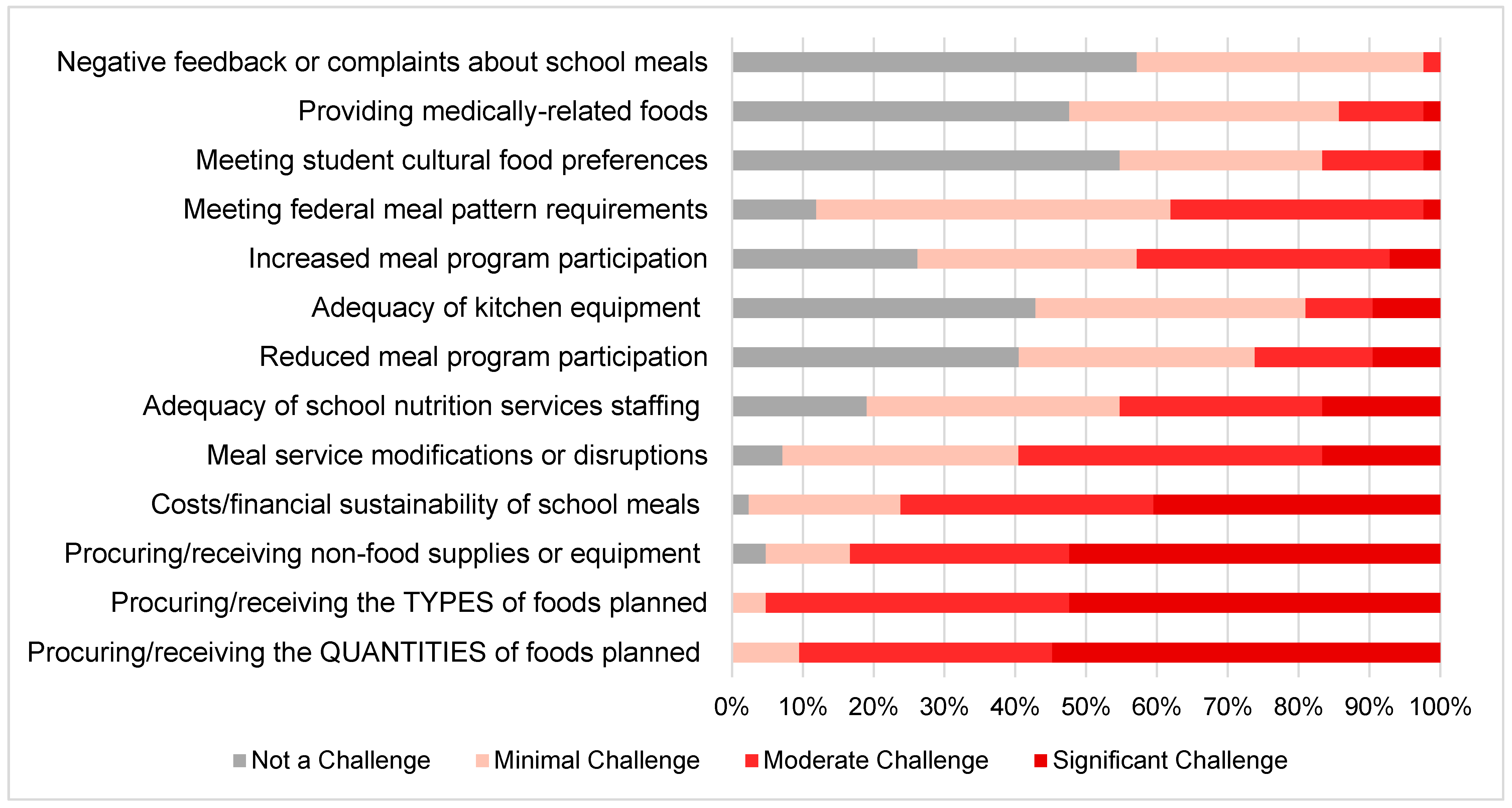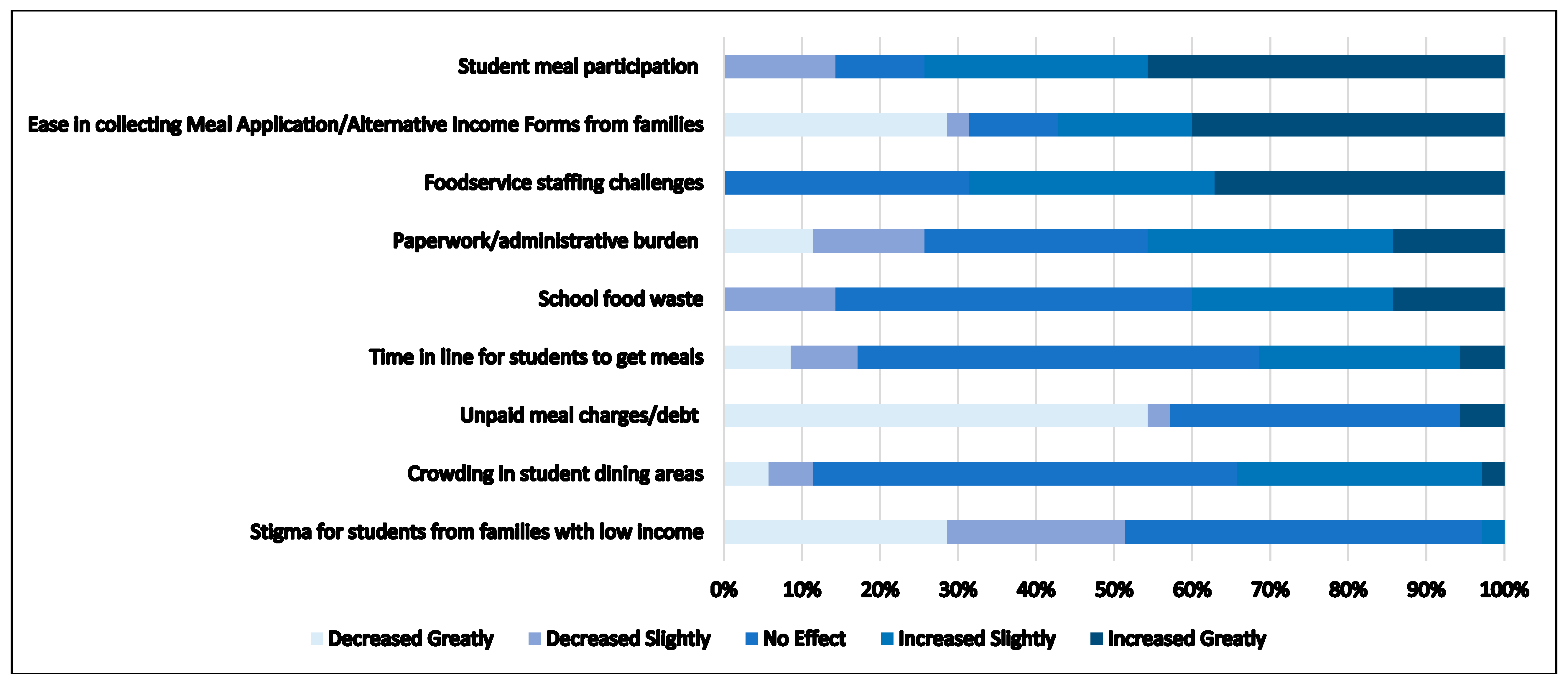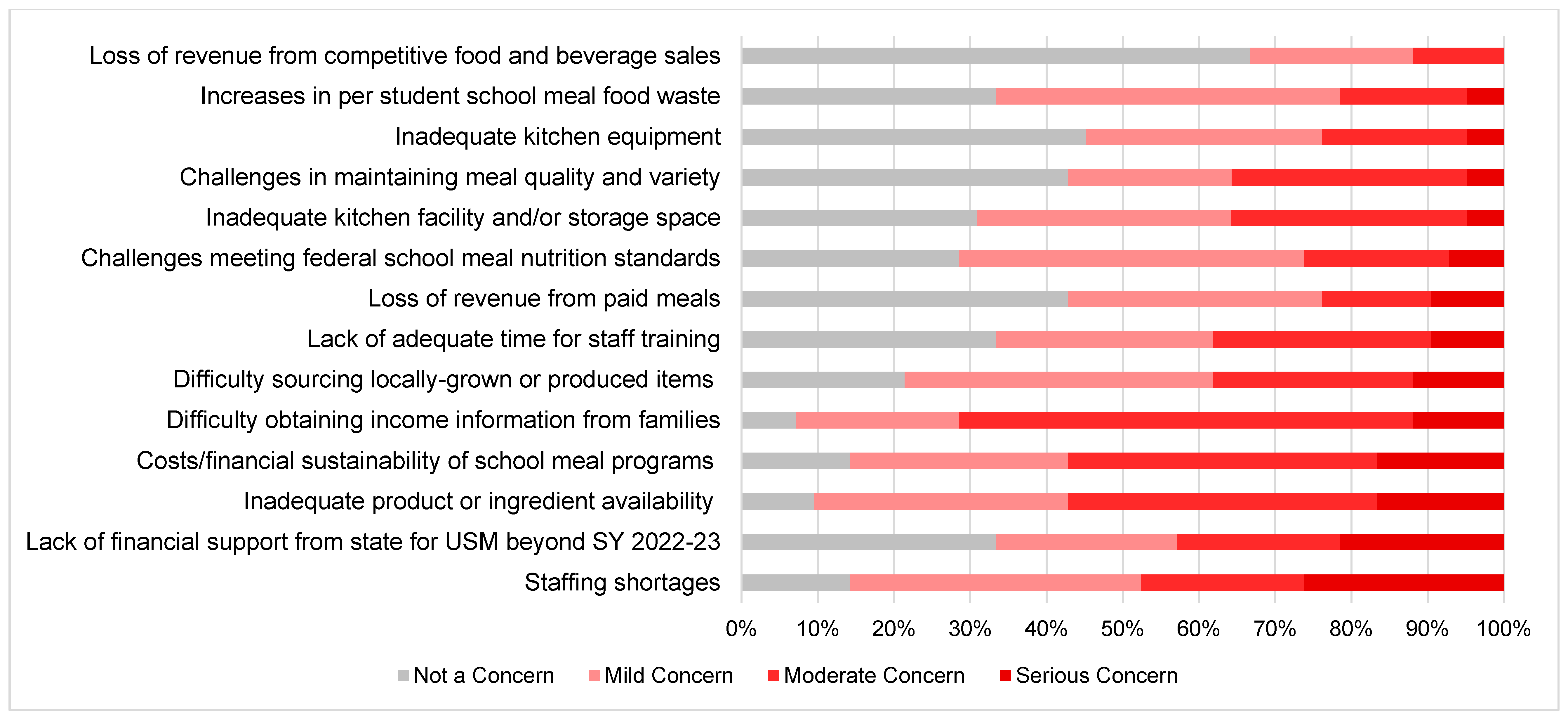Implementation of Universal School Meals during COVID-19 and beyond: Challenges and Benefits for School Meals Programs in Maine
Abstract
1. Introduction
2. Materials and Methods
2.1. Participants
2.2. Measures and Data Collection Procedures
2.3. Statistical Analyses
3. Results
3.1. Challenges Related to COVID-19 and/or Supply-Chain Issues during the School Year (SY) 2021–2022
3.2. Perceptions of Changes Due to Implementing USM during the School Year (SY) 2021–2022
3.3. Anticipated Concerns and Resources Needed in the Future (SY 2022–2023)
4. Discussion
5. Conclusions
Supplementary Materials
Author Contributions
Funding
Institutional Review Board Statement
Informed Consent Statement
Data Availability Statement
Acknowledgments
Conflicts of Interest
References
- Fox, M.K.; Gearan, E.; Cabili, C.; Dotter, D.; Niland, K.; Washburn, L.; Paxton, N.; Olsho, L.; LeClair, L.; Tran, V. School Nutrition and Meal Cost Study Final Report Volume 4: Student Participation, Satisfaction, Plate Waste, and Dietary Intakes. Math. Policy Res. 2019. Available online: https://www.fns.usda.gov/school-nutrition-and-meal-cost-study (accessed on 1 July 2022).
- World Health Organization. Food and Nutrition Policy for Schools: A Tool for the Development of School Nutrition Programmes in the European Region; WHO Regional Office for Europe: Copenhagen, Denmark, 2006.
- Dooris, M.; Poland, B.; Kolbe, L.; De Leeuw, E.; McCall, D.S.; Wharf-Higgins, J. Healthy settings. In Global Perspectives on Health Promotion Effectiveness; Springer: New York, NY, USA, 2007; pp. 327–352. [Google Scholar]
- Langford, R.; Bonell, C.P.; Jones, H.E.; Pouliou, T.; Murphy, S.M.; Waters, E.; Komro, K.A.; Gibbs, L.F.; Magnus, D.; Campbell, R. The WHO Health Promoting School framework for improving the health and well-being of students and their academic achievement. Cochrane Database Syst. Rev. 2014, CD008958. [Google Scholar] [CrossRef]
- Gearan, E.; Fox, M.K.; Niland, K.; Dotter, D.; Washburn, L.; Connor, P.; Olsho, L.; Wommack, T. School Nutrition and Meal Cost Study Final Report Volume 2: Nutritional Characteristics of School Meals. Math. Policy Res. 2019. Available online: https://fns-prod.azureedge.net/sites/default/files/resource-files/SNMCS-Volume2.pdf (accessed on 1 March 2020).
- Au, L.E.; Rosen, N.J.; Fenton, K.; Hecht, K.; Ritchie, L.D. Eating school lunch is associated with higher diet quality among elementary school students. J. Acad. Nutr. Diet. 2016, 116, 1817–1824. [Google Scholar] [CrossRef]
- Farris, A.R.; Misyak, S.; Duffey, K.J.; Davis, G.C.; Hosig, K.; Atzaba-Poria, N.; McFerren, M.M.; Serrano, E.L. Nutritional comparison of packed and school lunches in pre-kindergarten and kindergarten children following the implementation of the 2012–2013 national school lunch program standards. J. Nutr. Educ. Behav. 2014, 46, 621–626. [Google Scholar] [CrossRef] [PubMed]
- Au, L.E.; Gurzo, K.; Gosliner, W.; Webb, K.L.; Crawford, P.B.; Ritchie, L.D. Eating school meals daily is associated with healthier dietary intakes: The Healthy Communities Study. J. Acad. Nutr. Diet. 2018, 118, 1474–1481.e1471. [Google Scholar] [CrossRef] [PubMed]
- Mikkilä, V.; Räsänen, L.; Raitakari, O.; Pietinen, P.; Viikari, J. Consistent dietary patterns identified from childhood to adulthood: The cardiovascular risk in Young Finns Study. Br. J. Nutr. 2005, 93, 923–931. [Google Scholar] [CrossRef]
- Movassagh, E.Z.; Baxter-Jones, A.D.; Kontulainen, S.; Whiting, S.J.; Vatanparast, H. Tracking dietary patterns over 20 years from childhood through adolescence into young adulthood: The Saskatchewan Pediatric Bone Mineral Accrual Study. Nutrients 2017, 9, 990. [Google Scholar] [CrossRef]
- Whitaker, R.C.; Wright, J.A.; Pepe, M.S.; Seidel, K.D.; Dietz, W.H. Predicting obesity in young adulthood from childhood and parental obesity. N. Engl. J. Med. 1997, 337, 869–873. [Google Scholar] [CrossRef]
- Lytle, L.A.; Seifert, S.; Greenstein, J.; McGovern, P. How do children’s eating patterns and food choices change over time? Results from a cohort study. Am. J. Health Promot. 2000, 14, 222–228. [Google Scholar] [CrossRef]
- Fleischhacker, S.; Campbell, E. Ensuring equitable access to school meals. J. Acad. Nutr. Diet. 2020, 120, 893. [Google Scholar] [CrossRef] [PubMed]
- Potamites, E.; Gordon, A. Children’s Food Security and Intakes from School Meals. 2010. Available online: https://ageconsearch.umn.edu/record/292081/ (accessed on 1 July 2022).
- Mirtcheva, D.M.; Powell, L.M. Participation in the national school lunch program: Importance of school-level and neighborhood contextual factors. J. Sch. Health 2009, 79, 485–494. [Google Scholar] [CrossRef]
- Moore, Q.; Hulsey, L.; Ponza, M. Factors Associated with School Meal Participation and the Relationship between Different Participation Measures. 2009. Available online: https://ageconsearch.umn.edu/record/292073/ (accessed on 1 July 2022).
- Cohen, J.F.; Hecht, A.A.; McLoughlin, G.M.; Turner, L.; Schwartz, M.B. Universal School Meals and Associations with Student Participation, Attendance, Academic Performance, Diet Quality, Food Security, and Body Mass Index: A Systematic Review. Nutrients 2021, 13, 911. [Google Scholar] [CrossRef] [PubMed]
- Gross, S.M.; Kelley, T.L.; Augustyn, M.; Wilson, M.J.; Bassarab, K.; Palmer, A. Household Food Security Status of Families with Children Attending Schools that Participate in the Community Eligibility Provision (CEP) and Those with Children Attending Schools that are CEP-Eligible, but Not Participating. J. Hunger Environ. Nutr. 2019, 16, 281–296. [Google Scholar] [CrossRef]
- Beaton, M.; Craig, P.; Katikireddi, S.; Jepson, R.; Williams, A. Evaluability Assessment of Free School Meals for All Children in P1 to P3. Proj. Report. NHS Health Scotl. Edinb. 2014. Available online: www.healthscotland.com/uploads/documents/24294-Evaluability%20Assessment%20of%20Free%20School%20Meals%20(2).pdf (accessed on 1 July 2022).
- Poppendieck, J. Free for All: Fixing School Food in America; University of California Press: Berkeley, CA, USA, 2011; Volume 28. [Google Scholar]
- Wahlstrom, K.L.; Begalle, M.S. More than test scores: Results of the Universal School Breakfast Pilot in Minnesota. Top. Clin. Nutr. 1999, 15, 17–29. [Google Scholar] [CrossRef]
- Cullen, K.W.; Chen, T.-A. The contribution of the USDA school breakfast and lunch program meals to student daily dietary intake. Prev. Med. Rep. 2017, 5, 82–85. [Google Scholar] [CrossRef]
- Brown, K. School Meal Programs: Experiences of the States and Districts That Eliminated Reduced-Price Fees. Report to the Chairman, Committee on Education and Labor, House of Representatives; GAO-09-584; US Government Accountability Office: Washington, DC, USA, 2009.
- United States Department of Agriculture. National School Lunch Program and School Breakfast Program: Nutrition Standards for All Foods Sold in School as Required by the Healthy, Hunger-Free Kids Act of 2010. Fed Regist 2012, 81, 50131–50151. [Google Scholar]
- Levin, M.; Neuberger, Z. A guide to implementing community eligibility. Food Res. Action Cent. Cent. Budg. Policy Priorities Oct. 2013, 1. [Google Scholar]
- Billings, K.; Carter, J. Serving Free School Meals through the Community Eligibility Provision (CEP): Background and Participation. Congr. Res. Serv. May 2020, 20, 529–550. [Google Scholar]
- Feeding America. The Impact of the Coronavirus on National Food Insecurity in 2020 & 2021. Available online: https://www.feedingamerica.org/sites/default/files/2021-03/National%20Projections%20Brief_3.9.2021_0.pdf (accessed on 12 July 2022).
- United States Department of Agriculture. FNS Responds to COVID-19. Available online: https://www.fns.usda.gov/coronavirus (accessed on 1 July 2022).
- U.S. Department of Agriculture. School Nutrition and Meal Cost Study-School Meal Costs and Revenues; Office of Policy Support: Alexandria, VA, USA, 2019.
- U.S. Department of Agriculture. Results of the U.S. Department of Agriculture, Food and Nutrition Service-Administered School Food Authority Survey on Supply Chain Disruptions. 2022. Available online: https://www.fns.usda.gov/cn/results-fns-administered-school-food-authority-survey-supply-chain-disruption (accessed on 1 July 2022).
- U.S. Department of Agriculture. USDA Distributes $1.5 Billion to Strengthen School Meal Program. Food and Nutrition Service (FNS). 2021. Available online: https://www.usda.gov/media/press-releases/2021/12/17/usda-distributes-15-billion-strengthen-school-meal-program (accessed on 1 July 2022).
- California Department of Education. California Healthy Kids Study Key Informant Interview Guide for School Food & Nutrition Environment. 2015. Available online: https://www.cde.ca.gov/ls/he/at/chks.asp (accessed on 14 August 2022).
- Centers for Disease Control and Prevention. School Health Policies and Programs Study 2006-Food Service District Questionnaire. 2006. Available online: https://www.cdc.gov/healthyyouth/shpps/2006/factsheets/pdf/fs_overview_shpps2006.pdf (accessed on 1 July 2022).
- U.S. Department of Agriculture. SFA Survey on Supply Chain Disruption; Office of Policy Support: Lexandria, VA, USA, 2021.
- Rider, C.; Linares, A.; Kao, J.; Becker, C.; Woodward-Lopez, G. Assessing Healthful Eating and Physical Activity Practices in Places Children Learn. J. Ext. 2021, 58, 28. [Google Scholar]
- Ritchie, L.; Wakimoto, P.; Woodward-Lopez, G.; Thompson, F.; Loria, C.; Wilson, D.; Kao, J.; Crawford, P.; Webb, K. The Healthy Communities Study Nutrition Assessments: Child Diet and the School Nutrition Environment. Am. J. Prev. Med. 2015, 49, 647–652. [Google Scholar] [CrossRef] [PubMed]
- Hoffman, J.A.; Rosenfeld, L.; Schmidt, N.; Cohen, J.F.; Gorski, M.; Chaffee, R.; Smith, L.; Rimm, E.B. Implementation of competitive food and beverage standards in a sample of Massachusetts schools: The NOURISH study (Nutrition Opportunities to Understand Reforms Involving Student Health). J. Acad. Nutr. Diet. 2015, 115, 1299–1307.e1292. [Google Scholar] [CrossRef] [PubMed]
- U.S. Department of Agriculture. Summer Food Service Program. 2021 Reimbursement Rates; 7033052537; 2020. Available online: https://www.federalregister.gov/documents/2020/12/31/2020-29093/summer-food-service-program-2021-reimbursement-rates (accessed on 1 July 2022).
- United States Department of Agriculture. Biden Administration Takes Additional Steps to Strengthen Child Nutrition Programs; United States Department of Agriculture: Washion, DC, USA, 2022.
- Hecht, A.; Dunn, C.; Turner, L.; Fleischhacker, S.; Kenney, E.; Bleich, S. Improving Access to Free School Meals: Addressing Intersections between Universal Free School Meal Approaches and Educational Funding. Available online: https://healthyeatingresearch.org/wp-content/uploads/2021/07/HER-CEP-Policy-Brief.pdf (accessed on 1 July 2022).



| Respondent Characteristics | n (%) |
|---|---|
| Role | |
| School Nutrition Director/Foodservice Director | 31 (72%) |
| School Nutrition Supervisor/Manager | 6 (14%) |
| Other | 6 (14%) |
| Years in the Role | |
| <1 year | 1 (2%) |
| 1–4 years | 11 (26%) |
| 5–9 years | 15 (35%) |
| 10–14 years | 6 (14%) |
| 15–19 years | 4 (9%) |
| ≥20 years | 6 (14%) |
| Highest Education | |
| High School/GED | 9 (21%) |
| Some College (no degree) | 12 (28%) |
| Associate’s Degree | 6 (14%) |
| Bachelor’s degree | 13 (30%) |
| Master’s degree or more | 3 (7%) |
| SFA Characteristics | n (%) |
| Urbanicity 1 | |
| Small Town/Rural | 23 (54%) |
| Large Rural | 7 (16%) |
| Suburban | 6 (14%) |
| Urban | 7 (16%) |
| Availability of Free School Meals prior to COVID-19 2 | |
| Available in All Schools (yes) | 7 (17%) |
| Free School Breakfast 3 | |
| Elementary Schools | 14 (34%) |
| Middle Schools | 12 (34%) |
| High Schools | 9 (29%) |
| Free School Lunch 3 | |
| Elementary Schools | 9 (22%) |
| Middle Schools | 7 (20%) |
| High Schools | 5 (16%) |
| Food Preparation Location | |
| District nutrition services/Central kitchen | 15 (35%) |
| School sites | 24 (56%) |
| COVID-19 Related Challenges | Urbanicity 2 | Prior CEP Status 3 | ||
|---|---|---|---|---|
| β (SE) | p-Value | β (SE) | p-Value | |
| 0.26 (0.10) | 0.01 | −0.11 (0.32) | 0.7 |
| 0.01 (0.08) | 0.9 | 0.10 (0.2) | 0.7 |
| 0.01 (0.09) | 0.9 | 0.12 (0.28) | 0.6 |
| −0.09 (0.11) | 0.4 | −0.70 (0.34) | 0.04 |
| 0.09 (0.09) | 0.3 | 0.15 (0.29) | 0.6 |
| −0.21 (0.10) | 0.04 | 0.56 (0.31) | 0.07 |
| −0.12 (0.10) | 0.2 | −0.47 (0.31) | 0.1 |
| −0.16 (0.12) | 0.2 | −0.43 (0.37) | 0.2 |
| −0.14 (0.13) | 0.3 | 0.01 (0.40) | 0.9 |
| −0.12 (0.11) | 0.2 | 0.02 (0.33) | 0.9 |
| 0.04 (0.12) | 0.7 | −0.68 (0.37) | 0.06 |
| 0.05 (0.13) | 0.7 | 0.71 (0.39) | 0.07 |
| −0.02 (0.07) | 0.7 | 0.48 (0.21) | 0.02 |
| Perceived Concerns | Urbanicity 2 | Prior CEP Status 3 | ||
|---|---|---|---|---|
| β (SE) | p-Value | β (SE) | p-Value | |
| −0.05 (0.09) | 0.6 | −0.31 (0.27) | 0.5 |
| −0.06 (0.11) | 0.6 | −0.24 (0.35) | 0.5 |
| −0.08 (0.12) | 0.5 | −0.32 (0.37) | 0.4 |
| 0.06 (0.12) | 0.6 | −0.59 (0.36) | 0.1 |
| 0.25 (0.12) | 0.04 | 0.09 (0.38) | 0.8 |
| −0.23 (0.11) | 0.04 | 0.27 (0.35) | 0.4 |
| −0.08 (0.13) | 0.6 | −0.01 (0.40) | 0.9 |
| 0.34 (0.11) | 0.002 | −0.23 (0.34) | 0.5 |
| −0.31 (0.14) | 0.03 | 0.03 (0.45) | 0.9 |
| −0.23 (0.13) | 0.08 | −0.003 (0.40) | 0.9 |
| 0.22 (0.12) | 0.07 | −0.25 (0.37) | 0.5 |
| 0.12 (0.12) | 0.3 | −0.14 (0.36) | 0.7 |
| −0.20 (0.10) | 0.04 | 0.29 (−0.60) | 0.9 |
Publisher’s Note: MDPI stays neutral with regard to jurisdictional claims in published maps and institutional affiliations. |
© 2022 by the authors. Licensee MDPI, Basel, Switzerland. This article is an open access article distributed under the terms and conditions of the Creative Commons Attribution (CC BY) license (https://creativecommons.org/licenses/by/4.0/).
Share and Cite
Cohen, J.F.W.; Polacsek, M.; Hecht, C.E.; Hecht, K.; Read, M.; Olarte, D.A.; Patel, A.I.; Schwartz, M.B.; Turner, L.; Zuercher, M.; et al. Implementation of Universal School Meals during COVID-19 and beyond: Challenges and Benefits for School Meals Programs in Maine. Nutrients 2022, 14, 4031. https://doi.org/10.3390/nu14194031
Cohen JFW, Polacsek M, Hecht CE, Hecht K, Read M, Olarte DA, Patel AI, Schwartz MB, Turner L, Zuercher M, et al. Implementation of Universal School Meals during COVID-19 and beyond: Challenges and Benefits for School Meals Programs in Maine. Nutrients. 2022; 14(19):4031. https://doi.org/10.3390/nu14194031
Chicago/Turabian StyleCohen, Juliana F. W., Michele Polacsek, Christina E. Hecht, Ken Hecht, Margaret Read, Deborah A. Olarte, Anisha I. Patel, Marlene B. Schwartz, Lindsey Turner, Monica Zuercher, and et al. 2022. "Implementation of Universal School Meals during COVID-19 and beyond: Challenges and Benefits for School Meals Programs in Maine" Nutrients 14, no. 19: 4031. https://doi.org/10.3390/nu14194031
APA StyleCohen, J. F. W., Polacsek, M., Hecht, C. E., Hecht, K., Read, M., Olarte, D. A., Patel, A. I., Schwartz, M. B., Turner, L., Zuercher, M., Gosliner, W., & Ritchie, L. D. (2022). Implementation of Universal School Meals during COVID-19 and beyond: Challenges and Benefits for School Meals Programs in Maine. Nutrients, 14(19), 4031. https://doi.org/10.3390/nu14194031







